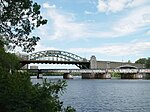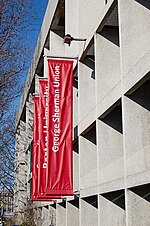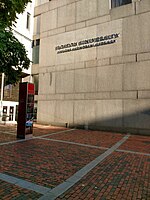Grand Junction Railroad Bridge
1927 establishments in MassachusettsBridges completed in 1927Bridges in BostonBridges in Middlesex County, MassachusettsBridges in Norfolk County, Massachusetts ... and 5 more
Bridges over the Charles RiverBuildings and structures in Cambridge, MassachusettsPlate girder bridges in the United StatesRailroad bridges in MassachusettsSteel bridges in the United States

The Grand Junction Railroad Bridge is a steel plate girder bridge carrying the Grand Junction Railroad over the Charles River in Boston, connecting the Boston University campus to Cambridgeport. In September 2009, the Commonwealth of Massachusetts finalized an agreement to purchase several CSX rail lines in eastern Massachusetts, including the Grand Junction tracks from the Beacon Park Yard in Allston, through Cambridge. The deal was closed on June 17, 2010.
Excerpt from the Wikipedia article Grand Junction Railroad Bridge (License: CC BY-SA 3.0, Authors, Images).Grand Junction Railroad Bridge
Storrow Drive, Boston Fenway / Kenmore
Geographical coordinates (GPS) Address Website External links Nearby Places Show on map
Geographical coordinates (GPS)
| Latitude | Longitude |
|---|---|
| N 42.352608333333 ° | E -71.110347222222 ° |
Address
Grand Junction Railroad Bridge
Storrow Drive
02215 Boston, Fenway / Kenmore
Massachusetts, United States
Open on Google Maps






